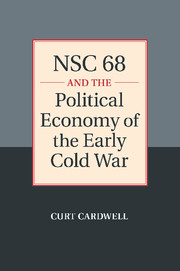Book contents
- Frontmatter
- Contents
- Acknowledgments
- Abbreviations
- Introduction
- 1 NSC 68 and the Problem of Origins
- 2 Multilateralism, the Soviet Threat, and the Origins of the Cold War
- 3 Multilateralism, the Dollar Gap, and the Origins of the Cold War
- 4 The Dollar Gap and Its Discontents
- 5 The British Sterling-Dollar Crisis of 1949–1950
- 6 The Origins and Development of NSC 68
- 7 The Political Economy of Rearmament
- Conclusion
- Select Bibliography
- Index
- References
6 - The Origins and Development of NSC 68
Published online by Cambridge University Press: 05 July 2011
- Frontmatter
- Contents
- Acknowledgments
- Abbreviations
- Introduction
- 1 NSC 68 and the Problem of Origins
- 2 Multilateralism, the Soviet Threat, and the Origins of the Cold War
- 3 Multilateralism, the Dollar Gap, and the Origins of the Cold War
- 4 The Dollar Gap and Its Discontents
- 5 The British Sterling-Dollar Crisis of 1949–1950
- 6 The Origins and Development of NSC 68
- 7 The Political Economy of Rearmament
- Conclusion
- Select Bibliography
- Index
- References
Summary
What we work toward must be on a higher plane than a solution of the Russian problem. That happens to be a major irritation in the side of western civilization today but that may be a benefit, because it may make us think. It is an abnormal power relationship which we have to deal with today.
George Kennan, June 13, 1950The purpose of NSC-68 was to so bludgeon the mass mind of “top government” that not only could the President make a decision but that the decision could be carried out.
Dean Acheson, 1969NSC 68, and the rearmament program that it spawned, fundamentally altered the course of the Cold War. The Cold War certainly had begun as early as 1946–1947, but it did not become the rigid standoff that characterized it for the roughly forty years after 1950 until the advent of NSC 68. NSC 68 was a point of departure for the United States in its relations with the Soviet Union and virtually the entire world. It marked the point at which the country, under the guidance of the multilateralists in the Truman administration and their private colleagues, gave up any and all pretense of cooperating with the Soviet Union and took the position that only unbridled power in its own hands – hegemony – could secure the kind of world that would allow the United States itself to function along liberal capitalist democratic lines, a world defined in terms of multilateralism by those committed to multilateralism.
- Type
- Chapter
- Information
- NSC 68 and the Political Economy of the Early Cold War , pp. 160 - 210Publisher: Cambridge University PressPrint publication year: 2011

